For centuries Red Square has been the nucleus of life in Moscow. It has evolved from being a simple medieval market, to the setting of glorious Soviet military parades, to the symbolic centre of Russia today. Situated between the Kremlin and historic Kitai-Gorod district and surrounded by the city’s most famous landmarks, it’s impossible to appreciate Moscow without a visit to Red Square.
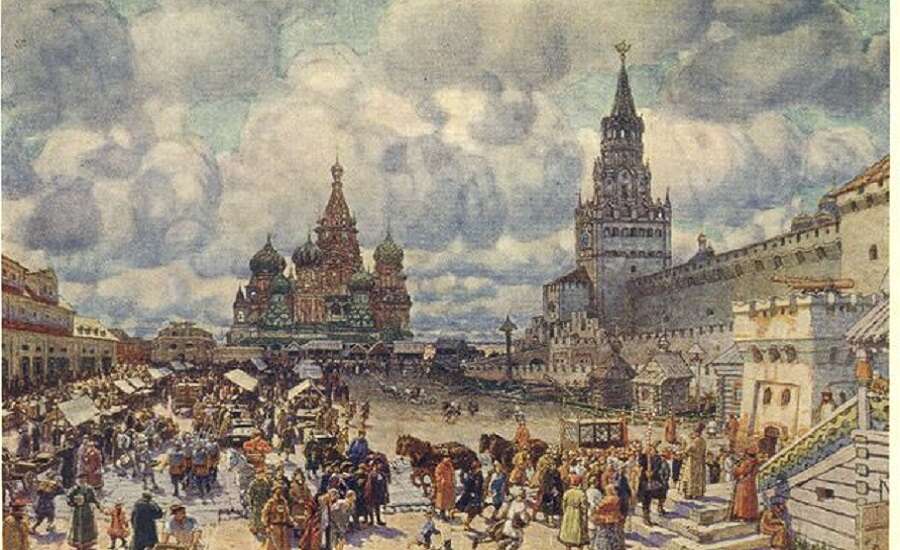
Photo by Аполлинарий Михайлович Васнецов on Wikipedia
Although Red Square calls to mind images of Soviet Russia and Lenin, its history stretches back for nearly a millennium. Its territory is ideally located on a hill at the confluence of the Moskva and Neglinnaya Rivers and was used since the 11th century for farming and trade. By the late 1400s this had developed into an established marketplace alongside the Moscow Kremlin.
Did you know? Red Square was initially known by other names: Torg, meaning ‘market’, Pozhar, meaning ‘fire’, and Troitsky, meaning ‘Trinity’. A common misconception is that the square takes its current name from the red Kremlin walls or as a connection with Communism. In fact, krasnyi (red) derives from the Russian word krasivyi, meaning ‘beautiful’. The square did not take this name until the mid-1600s.
In the 16th and 17th centuries, Red Square was the centre of political, civil and economic life in Moscow. It was a melting pot of activity. To one side lay the bustling Kitai-Gorod where Moscow’s inhabitants lived, to the other the Kremlin with its cathedrals and palaces, and in the centre a bazaar bustling with people day and night. On Red Square, people could also listen to the Tsar’s addresses and get involved in political activity.
The construction of St Basil’s Cathedral embodied this mix, an Orthodox institution with a colourful medley of architecture contrasting the Kremlin’s restrained white-stone churches. After continual fires devastated Red Square, the market was rebuilt in the late 1600s with stone shops creating a real shopping arcade with all kinds of products and services, from stalls peddling local delicacies to taverns, passenger cabs and blacksmiths.
Did you know? By the mid 17th century nearly 700 shops operated on Red Square!
After St Petersburg was made the capital of the Russian Empire, Red Square fell into disrepair. This was compounded by the damage caused by Napoleon’s army invading Moscow in 1812. But in the late 1800s the square resumed its former importance, with the construction of a State History Museum, a brand-new shopping centre, and tram lines. At this point, Red Square began to assume its present shape.
Did you know? Red Square is 330 metres long and 75 metres wide, approximately the size of three football fields. Despite its fame, it is certainly not the biggest square in Russia, or even in Moscow!
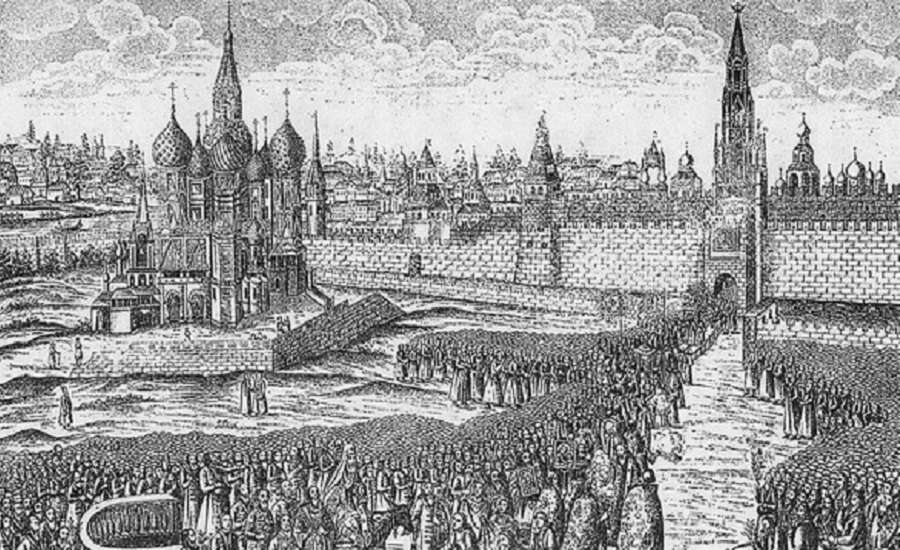
Photo by http://www.thg.ru/education/dva_grada/dva_grada-01.html on Wikipedia
The October Revolution heralded a new era for Red Square. It became the ideological and political centre of the new Soviet state, whose government relocated to the adjoining Moscow Kremlin. Lenin rallied the Muscovites from the square to join his cause, soldiers who died in revolutionary battles were buried in a necropolis along its western wall, and military and sporting parades took place there.
Did you know? The Soviets planned to destroy many important buildings on Red Square, including St Basil’s Cathedral, to accommodate military parades and an enormous skyscraper housing the People’s Commissariat of Industry.
One military parade, held on the 7th November 1941, carried particular significance. Soldiers taking part proceeded directly from Red Square to the war front. In order to protect the square from German reconnaissance and bombing, it was disguised with ‘streets’ of wooden structures, and important buildings such as St Basil’s and the Mausoleum were masked with fabric and paint. A glorious victory parade was held on Red Square on 24th June 1945 to celebrate the end of the war in Russia.
Did you know? The first American film for which the Soviet authorities permitted filming on Red Square was Red Heat, starring Arnold Schwarzenegger as a Soviet policeman.
Red Square was finally reopened for general access in 1963, and was designated a UNESCO World Heritage Site in 1990. Since the collapse of the Soviet Union, Red Square has hosted many famous concerts and every year celebrations and parades continue to take place there.
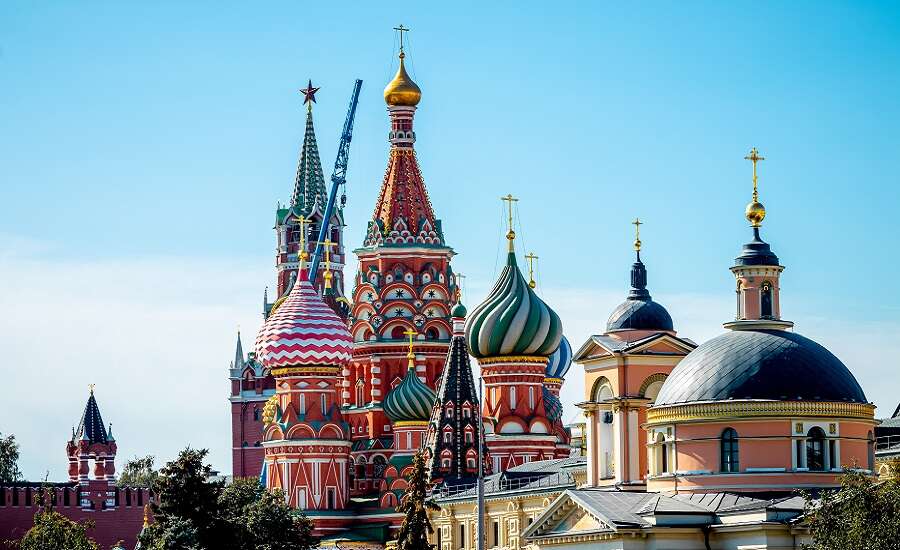
Photo by Artem Beliaikin on Unsplash
Russia’s most recognisable cathedral, famous for its colourful onion domes. St Basil’s Cathedral was commissioned in the mid-1550s by Ivan the Terrible, who subsequently had its architect blinded so that such a wondrous sight could never be recreated. The cathedral is dedicated to Saint Basil the Blessed, a holy fool who lived in the 1500s, and is also known as Pokrovsky Cathedral.
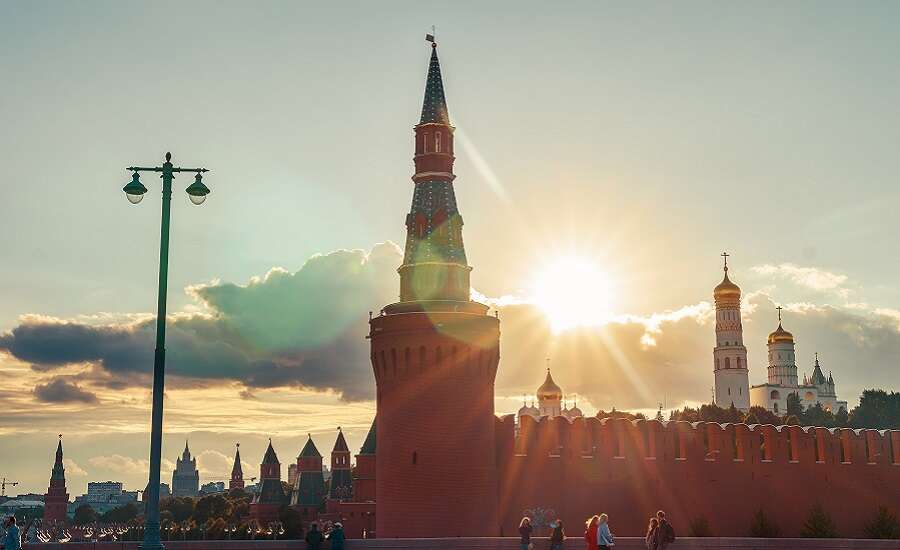
Photo by Vitolda Klein on Unsplash
The Kremlin has been a unique monument of Russian culture and a symbol of Russian statehood from medieval Russia until the present day, where it houses the ceremonial residence of the President of Russia. Visitors to the Kremlin can see many cathedrals and churches, visit the 20 towers protecting the Kremlin’s walls, and book a private tour to explore its palaces.
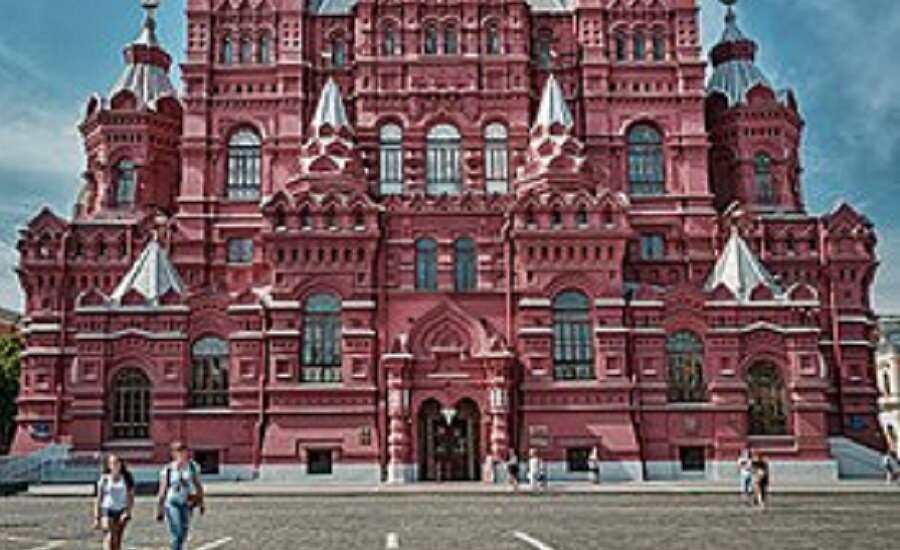
Phtoto by Skif-Kerch on Wikipedia
Russia’s largest national history museum, with exhibits from the Stone Age to the 19th century. There is no better place to gain a comprehensive understanding of Russia’s political, religious, and cultural history, and to discover how Russia evolved from a land of disparate tribes into the superpower that it is today. The museum is housed in an imposing dark red building on Red Square’s north-west side.

Photo by DIMSFIKAS on Wikipedia
On the western side of Red Square, next to the Kremlin wall, is the Mausoleum of Vladimir Lenin. Inside the solemn red, grey and black structure is a transparent sarcophagus in which lies Lenin’s embalmed body. Apopular tourist attraction on Red Square, it’s necessary to plan your visit carefully as the mausoleum is only open four days a week from 10:00 – 13:00. The mausoleum stands in the centre of the Red Square Necropolis, a tiered memorial cemetery where many important Soviet figures, revolutionary soldiers, and foreign Communists are commemorated.
Did you know? Stalin’s body also lay in the mausoleum from 1953 – 1961, until it was removed as part of the process of Destalinization.

Photo by Asif Masimov on Wikipedia
Moscow’s most famous and beautiful department store, which evolved out of the trading rows established on Red Square in previous centuries. The architect responsible for the department store, Alexander Pomerantsev, won a competition with his fabulous design. It is worth exploring GUM even if you don’t want to buy anything, but just to take in the opulent setting.
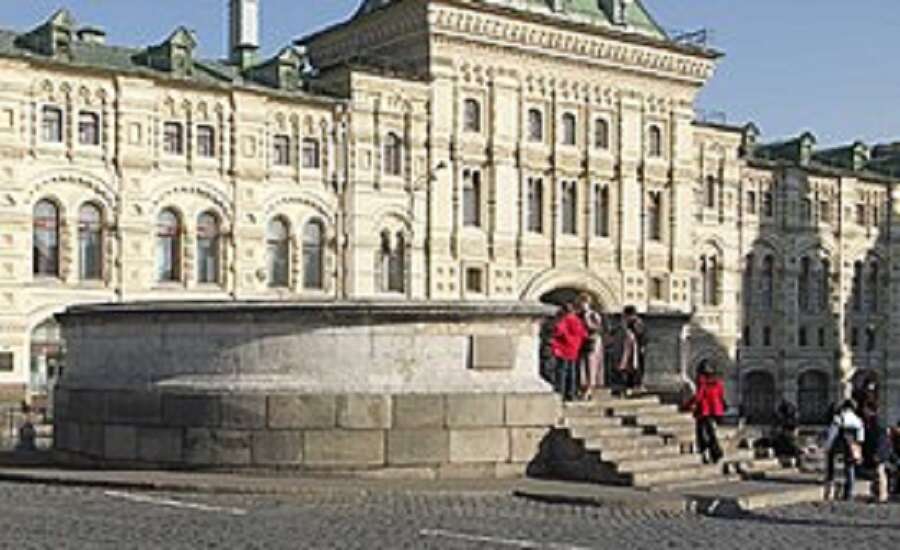
Photo on Wikipedia
This large stone platform is the most ancient remaining place of Red Square. From here, the tsars gave speeches, presented decrees, announced executions and wars, and led solemn ceremonies. At other times the nobility would be brought here and prosecuted in a ‘civil execution’- not a bloodthirsty affair, but a humiliating ceremony in whichd is graced nobles were stripped of their rank and title. Nevertheless, this spot has seen its fair share of bloodshed. Bodies of enemies of the state were displayed here, and very occasionally executions were carried out on the platform.
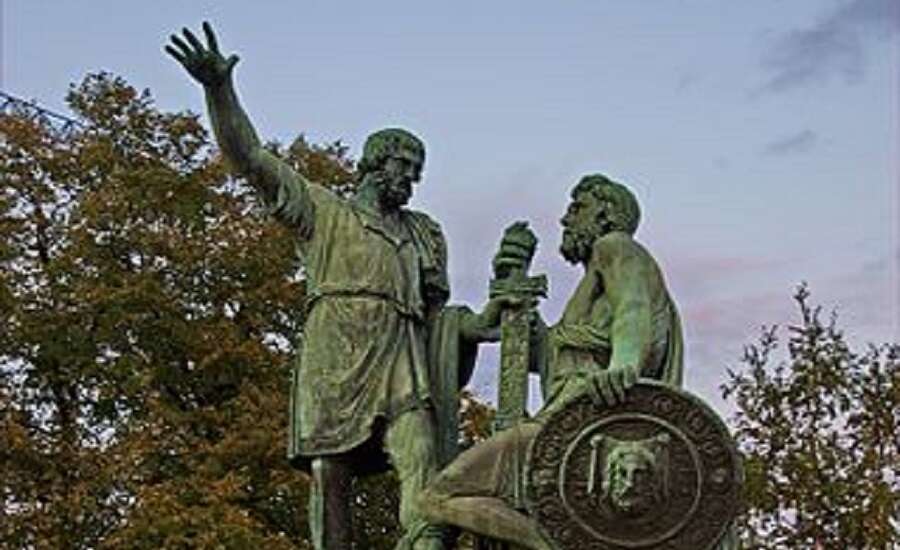
Photo by Uwe Brodrecht on Wikipedia
Kuzma Minin and Prince Dmitry Pozharsky defended Russiain the Battle of Moscow against the Polish invaders in 1612. They are honoured in this monument which stands pride of place in front of St Basil’s Cathedral. It depicts Minin rallying Pozharsky and Nizhny Novgorod’s inhabitants to defend their capital. The Day of National Unity, dedicated to the two men, takes place on 4th November each year and people come to lay flowers at the monument.
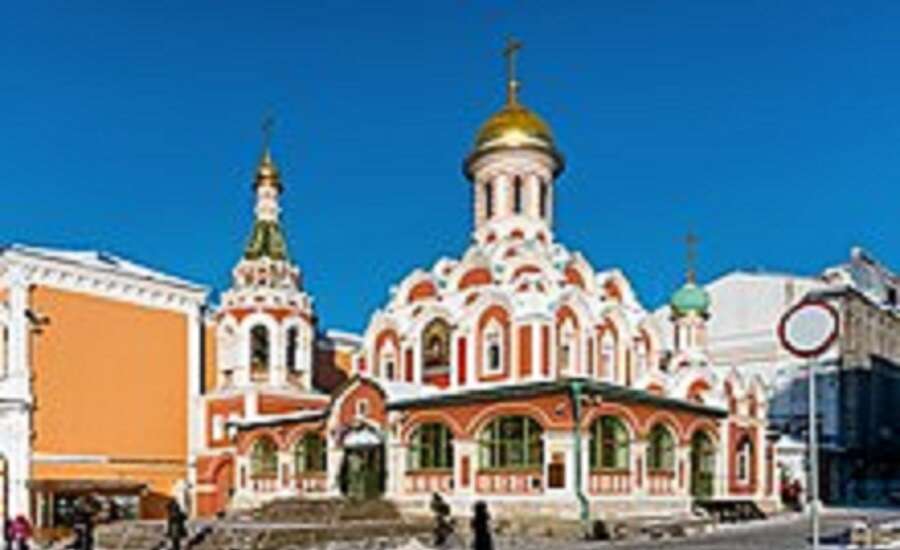
Photo on Wikipedia
The cathedral was commissioned by Prince Pozharsky in honour of the 1612 Battle of Moscow. It was unfortunately destroyed by the Soviets in 1936 as part of the large-scale clearing of Red Square. Luckily, architect Peter Baranovsky took meticulous measurements and photographs of the cathedral prior to its destruction, allowing for reconstruction which began in 1990. The cathedral stands today in Russian architectural style faithful to its original design, with a tiered pyramid of kokoshniks (semi-circular decorative elements) leading to a central gilded dome.
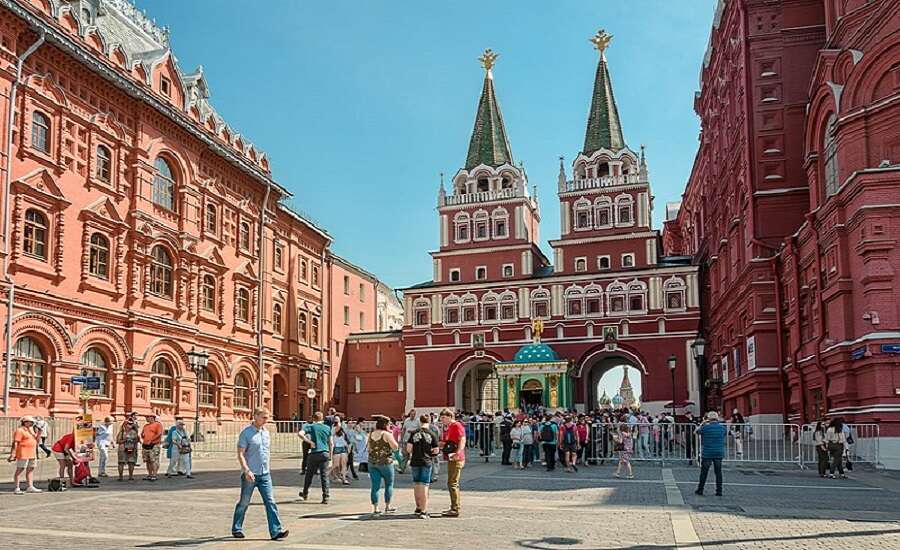
Photo by Skif-Kerch on Wikipedia
These gates were built in the medieval period and were a very important part of Red Square’s ensemble. Upon entering Moscow, Russian tsars proceeded through them and prayed to the revered Iverskoy Icon, housed there today in a gold and turquoise chapel adjoining the gates.
Did you know? At the Voskresensky Gates stands the Nulevoy kilometr (Kilometre Zero), a circular plaque on the ground marking the point from which all road distances in Russia are measured. To make a wish, stand on one leg on the plaque, look at the Iverskoy Chapel, and throw money over your left shoulder so that it lands within the border of the plaque!
As Moscow’s most important square, many festivals, parades and celebrations are hosted on Red Square throughout the year. Some of the most famous include the Christmas Market and ice rink, New Year’s celebrations, Victory Day Parade (9th May), Russia Day (12th June),the Spasskaya TowerMilitary Music Festival (August/September), and the Historical Parade (7th November). Here you may learn more about Russian public holidays and celebrations.
To see the best of what Red Square and its surroundings have to offer, why not take one of Express to Russia’s private guided tours?

Address and Contact Details
Red Square, Moscow, 109012
https://www.kreml.ru/
Metro: Borovitskaya/Biblioteka Imeni Lenina/Alexandrovsky Sad,
Teatralnaya/Ploshchad Revolutsii/Oxotny Ryad
Opening Hours
Red Square is open 24 hours a day.
Access is restricted on certain days for events, so make sure to check beforehand.
Visit the websites of Red Square’s surrounding landmarks to find their opening hours.
Join us on Facebook
We invite you to become a fan of our company on Facebook and read Russian news and travel stories. To become a fan, click here.
Join our own Russian Travel, Culture and Literature Club on Facebook. The club was created to be a place for everyone with an interest in Russia to get to know each other and share experiences, stories, pictures and advice. To join our club, please follow this link.